I know subject of my last few posts blur the areas I’m trying to cover, but I really want to state the importance of including all related and important material on the subject for future reference.
In 1981, a Science Fiction fanzine was published, a publication hand in hand with the comics industry at the time. Orion Magazine: The Canadian Magazine of Space and Time was first published in the summer of 1981 by Discovery Publications in Montreal, Quebec. This exceptional magazine was published and edited by a young, 18-year-old Mark Shainblum. His intent, very clear not to alienate other nationalities, was to provide a fanzine that fairly examined most English speaking science fiction and comics output, but of course, Canadian based. That said, the magazine was definitely Canadian content heavy.

Accompanying letter.
The first issue is perhaps most noted for Shainblum’s article on Captain Canuck and an interview with Richard Comely. Sadly, the inaugural issue of this series was already printed and ready to be shipped around the same time CKR Productions ceased publishing. In order to remain topical, Discovery included this letter also provided here by Mike Sterling.
Orion #1 contains several other timely references including a rare article on small time zine publisher Kenny Moran Comics out of Winnipeg, Manitoba and a comic entitled Captain Chinook by Captain Canuck artist Claude St. Aubin. Otherwise, the fanzine is 36 pages, oversized, black and white with colour cover and mostly a compilation of reviews, interviews, poetry, etc. at .
The second issue was almost double the length at 64 pages and slightly larger than the first. As far as luck goes though, it didn’t fair much better. Shortly after giving a long, in depth interview to Shainblum for the magazine, Gene Day passed away at only 36. Fortunately, Orion wasn’t already printed and Shainblum was able to explain that it was one of Day’s last interviews. Like the first issue, the second contains several excellent supporting pieces including a comic by Geof Isherwood called White Thunder and a Captain Canuck parody comic called Captain Canduck.
Orion only saw two printed issues before retiring in 1982. This was not the end though. In 2004, Shainblum resurrected Orion digitally with Comicopia for six more issues, all of which can be read here. Should you want a copy of the earlier Orion issues, you may be able to aquire copies directly from Shainblum himself.
Until then, here is the content of the first and second issue.
Orion #1
- Quantum (Editorial) – Mark Shainblum
- The Definitive Batman – James J.J. Wilson
- Broadening Horizons: First Encounter with The Spirit – Mark Shainblum
- Captain Canuck: The Triumphant Return of the Canadian Hero – Mark Shainblum
- World of Elzon: Imaginitive but… – Mark Shainblum
- Update (News from the World of SF) – Michael Gilson
- The Wager – Michael Gilson
- Ode to a Super Hero – Mark Shainblum
- “Orion Interview” A Conversation with Richard Comely – Mark Shainblum
- “Viewpoint” Commentary – Michael Gilson
- Software: Harlan Ellison reviewed – James J.J. Wilson
- The Ubiquitous Captain Chinook – Jean-Claude St. Aubin
- “MediaViews” Galactica: What Happened? – Michael Gilson
- Books: North By 2000 – Review by Mark Shainblum
- Pharma – Mark Shainblum
- The Riddle – Rhonda Kert
- Afterburn: Closing Commentary – Mark Shainblum
Orion #2
- Quantum (Editorial) – Mark Shainblum
- Orion Response (Letters)
- Comicswatch (Reviews)
- An Interview with Marv Wolfman – Mark Shainblum
- Another Interview – Gabrielle Morrisette
- The Loneliness of the Long Distance Writer – Lesley Choyce
- White Thunder – Geof Isherwood
- The Last Interview: A Conversation with Gene Day Mark Shainblum
- Fanwatch (Fanzine Reviews)
- Captain Canduck – John Bell (Words) Owen Oulton (Art)
- …And the Canadian Way? – Christine Kulyk
- Books (Reviews)
- Brass Orchids (Column) – Lisa Cohen
- Afterburn (Closing Commentary) Mark Shainblum

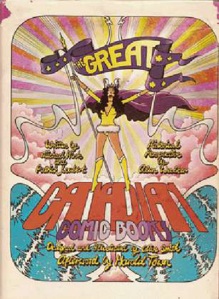 Basically, nothing really happened until 1971. Canadian comics were being produced in different ways, educational, underground, etc., but the first reference book on the subject that talked about superheroes and proper mainstream comics from Canada was Michael Hirsh and Patrick Loubert’s The Great Canadian Comic Books. This book is basically a look into perhaps the most successful, and most Canadian, comics produced during the forties and includes histories and excerpts on almost all facets of the Bell Features collection including Nelvana, The Penguin, Johnny Canuck and popular genres. It was published kind of as a companion to an exhibition that was happening at the time.
Basically, nothing really happened until 1971. Canadian comics were being produced in different ways, educational, underground, etc., but the first reference book on the subject that talked about superheroes and proper mainstream comics from Canada was Michael Hirsh and Patrick Loubert’s The Great Canadian Comic Books. This book is basically a look into perhaps the most successful, and most Canadian, comics produced during the forties and includes histories and excerpts on almost all facets of the Bell Features collection including Nelvana, The Penguin, Johnny Canuck and popular genres. It was published kind of as a companion to an exhibition that was happening at the time. Unfortunately, this book is rare. Published in 1971 by Peter Martin and Associates Limited, it had a smaller print run. Being about comics, Canadian comics even, especially in the seventies, didn’t automatically mean great sales. It was published with two editions, but the only difference is that the second edition has a different cover. You can find it online, but it’s not cheap. The good news is that it was republished in Alter Ego #71. The other good news is that, if you’re on a budget, you can buy a digital copy for cheap, but they do have back issues as well. The bad news is that the republication does not include all of the Bell Features excerpts that the original does. You’ll find a link near the end to purchase these online.
Unfortunately, this book is rare. Published in 1971 by Peter Martin and Associates Limited, it had a smaller print run. Being about comics, Canadian comics even, especially in the seventies, didn’t automatically mean great sales. It was published with two editions, but the only difference is that the second edition has a different cover. You can find it online, but it’s not cheap. The good news is that it was republished in Alter Ego #71. The other good news is that, if you’re on a budget, you can buy a digital copy for cheap, but they do have back issues as well. The bad news is that the republication does not include all of the Bell Features excerpts that the original does. You’ll find a link near the end to purchase these online.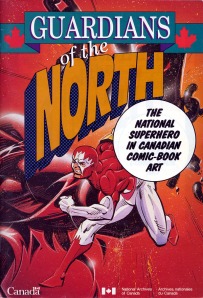
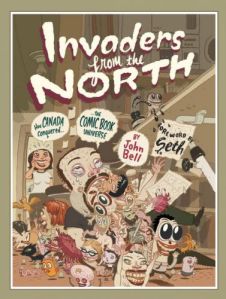 Finally, the real treasure trove of information can be found in John Bell’s Invaders From the North: How Canada Conquered the Comic Book Universe. This was released in 2006 by Dundurn Press in Toronto. It features a concise history of comics in Canada from the man who essentially put it together. Since its publication the book has been remaindered, and is quickly becoming another rare book on a long list of rare books about and of Canadian comics.
Finally, the real treasure trove of information can be found in John Bell’s Invaders From the North: How Canada Conquered the Comic Book Universe. This was released in 2006 by Dundurn Press in Toronto. It features a concise history of comics in Canada from the man who essentially put it together. Since its publication the book has been remaindered, and is quickly becoming another rare book on a long list of rare books about and of Canadian comics. 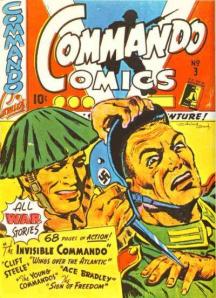 Bell Features, the truest of Canadian Golden Age comics published several titles during the 40’s including the aforementioned Active Comics.
Bell Features, the truest of Canadian Golden Age comics published several titles during the 40’s including the aforementioned Active Comics.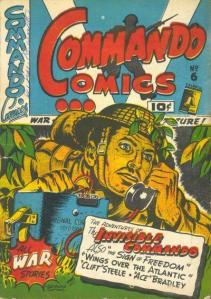 Like Active Comics, Commando Comics was themed, and in this case, based heavily on combat, war, secret missions, the Axis, and really, all other things commando. This theme was common during the war as it fueled nationalism and support and provided a more realistic hero. Active comics’ had Dixon of the Mounted, The Brain, Thunderfist, Active Jim and Captain Red Thorton which all featured daring action adventure stories. Likewise, Commando Comics had The Young Commandos, The Sign of Freedom, Wings Over the Atlantic, The Invisible Commando, Ace Bradley and Clift Steele. These stories shared a similar theme and formula which is evident in the cover pages pictured, and produced a very tight comic. This consistency lasted until about issue #15 when some of the more regular titles began to slowly drop off.
Like Active Comics, Commando Comics was themed, and in this case, based heavily on combat, war, secret missions, the Axis, and really, all other things commando. This theme was common during the war as it fueled nationalism and support and provided a more realistic hero. Active comics’ had Dixon of the Mounted, The Brain, Thunderfist, Active Jim and Captain Red Thorton which all featured daring action adventure stories. Likewise, Commando Comics had The Young Commandos, The Sign of Freedom, Wings Over the Atlantic, The Invisible Commando, Ace Bradley and Clift Steele. These stories shared a similar theme and formula which is evident in the cover pages pictured, and produced a very tight comic. This consistency lasted until about issue #15 when some of the more regular titles began to slowly drop off. It wasn’t really a surprise when Bell Features again began changing their lineup. Slowly, almost all of the above titles were phased out and replaced with gag comics or funnies by Robert Young, Thomas, Frank Keith, Harry Brunt and Hy Moyer. For stories they started using titles like the Polka Dot Pirate (A female avenger of sorts), Ruff and Reddy, Mr. Distracted Attorney, Salty Lane (Secret Investigator), Dick Stone, Chick Tucker and Flame Berns. There was even a Doc Stearne thrown in there. Beyond the obvious ridiculousness of the characters, the comic became unrecognizable to its former self.
It wasn’t really a surprise when Bell Features again began changing their lineup. Slowly, almost all of the above titles were phased out and replaced with gag comics or funnies by Robert Young, Thomas, Frank Keith, Harry Brunt and Hy Moyer. For stories they started using titles like the Polka Dot Pirate (A female avenger of sorts), Ruff and Reddy, Mr. Distracted Attorney, Salty Lane (Secret Investigator), Dick Stone, Chick Tucker and Flame Berns. There was even a Doc Stearne thrown in there. Beyond the obvious ridiculousness of the characters, the comic became unrecognizable to its former self.